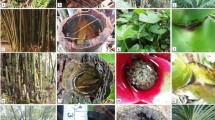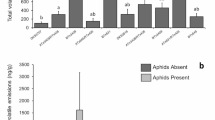Abstract
We tested in the field the hypothesis that the specialist butterfly Euphydryas aurinia (Lepidoptera: Nymphalidae, Melitaeinae) lays eggs on leaves of Lonicera implexa (Caprifoliaceae) plants with greater iridoid concentrations. We conducted our investigations in a Mediterranean site by analyzing leaves with and without naturally laid egg clusters. There were no significant differences in iridoid glycoside concentrations between leaves from plants that did not receive eggs and the unused leaves from plants receiving eggs, a fact that would seem to indicate that E. aurinia butterflies do not choose plants for oviposition by their iridoid content. However, the leaves of L. implexa that bore egg clusters had dramatically greater (over 15-fold) concentrations of iridoid glycosides than the directly opposite leaves on the same plant. These huge foliar concentrations of iridoids (15% leaf dry weight) may provide specialist herbivores with compounds that they either sequester for their own defense or use as a means of avoiding competition for food from generalist herbivores. Nevertheless, it may still be possible that these high concentrations are detrimental to the herbivore, even if the herbivore is a specialist feeder on the plant.



Similar content being viewed by others
References
Adler, L. S., Schmitt, J., and Bowers, M. D. 1995. Genetic variation in defensive chemistry in Plantago lanceolata (Plantaginaceae) and its effect on the specialist herbivore Junonia coenia (Nymphalidae). Oecologia 101:75–85.
Belofsky, G. M., Bowers, M. D., Janzen, S., and Stermitz, F. 1989. Iridoid glycosides of Aureolaria flava and their sequestration by Euphydryas phaeton butterflies. Phytochemistry 28:1601–1604.
Bowers, M. D. 1980. Unpalatability as a defense strategy of Euphydryas phaeton (Lepidoptera: Nymphalidae). Evolution 34:586–600.
Bowers, M. D. 1981. Unpalatability as a defense strategy of western checkerspot butterflies (Euphydryas Scudder, Nymphalidae). Evolution 35:367–375.
Bowers, M. D. 1991. Iridoid glycosides, pp. 297–325, in G. A. Rosenthal and M. R. Berenbaum (eds.). Herbivores: Their Interactions with Secondary Plant Metabolites. Vol. 1: The Chemical Participants. 2nd ed. Academic Press, San Diego, CA.
Bowers, M. D. and Puttick, G. M. 1986. Fate of ingested iridoid glycosides in lepidopterous herbivores. J. Chem. Ecol. 12:169–178.
Bowers, M. D. and Puttick, G. M. 1988. Response of generalist and specialist insects to qualitative allelochemical variation. J. Chem. Ecol. 14:319–334.
Bowers, M. D. and Williams, E. H. 1995. Variable chemical defense in the checkerspot butterfly, Euphydryas gillettii (Lepidoptera: Nymphalidae). Ecol. Entomol. 20:208–212.
Bowers, M. D., Collinge, S. K, Gamble, S. E., and Schmitt, J. 1992. Effects of genotype, habitat, and seasonal variation on iridoid glycoside content of Plantago lanceolata (Plantaginaceae) and the implications for insect herbivores. Oecologia 91:201–207.
Camara, M. D. 1997. A recent host range expansion in Junonia coenia Hübner (Nymphalidae): Oviposition preference, survival, growth, and chemical defense. Evolution 51:873–884.
Colazza, S., Fucarino, A., Peri, E., Salerno, G., Conti, E., and Bin, F. 2004. Insect oviposition induces volatile emission in herbaceous plants that attracts egg parasitoids. J. Exp. Biol. 207:47–53.
Darrow, K. and Bowers, M. D. 1997. Phenological and population variation in iridoid glycosides of Plantago lanceolata (Plantaginaceae). Biochem. Syst. Ecol. 25:1–12.
Dyer, L. A. 1995. Tasty generalists and nasty specialists? A comparative study of antipredator mechanisms in tropical lepidopteran larvae. Ecology 76:1483–1496.
Franke, A., Rimpler, H., and Schneider, D. 1987. Iridoid glycosides in the butterfly Euphydryas cynthia (Lepidoptera, Nymphalidae). Phytochemistry 26:103–106.
Gardner, D. R. and Stermitz, F. R. 1988. Host plant utilization and iridoid glycoside sequestration by Euphydryas anicia (Lepidoptera: Nymphalidae). J. Chem. Ecol. 14:2147–2168.
Harvey, J. A., Van Nouhuys, S., and Biere, A. 2005. Effects of quantitative variation in allelochemicals in Plantago lanceolata on development of a generalist and a specialist herbivore and their endoparasitoids. J. Chem. Ecol. 31:287–302.
Herms, D. A. and Mattson, W. J. 1992. The dilemma of plants: to grow or to defend. Q. Rev. Biol. 67:293–335.
Hilker, M., Rohfritsch, O., and Meiners, T. 2002. The plant's response towards insect oviposition, pp. 205–234, in M. Hilker, and T. Meiners (eds.). Chemoecology of Insect Eggs and Egg Deposition. Blackwell, Berlin.
Hilker, M., Stein, C., Schröder, R., Varama, M., and Mumm, R. 2005. Insect egg deposition induced defence response in Pinus sylvestris. Characterization of the elicitor. J. Exp. Biol. 208:1849–1854.
Kankare, M., Stefanescu, C., Van Nouhuys, S., and Shaw, M. R. 2005. Host specialization by Cotesia wasps (Hymenoptera: Braconidae) parasitising species-rich Melitaeini (Lepidoptera: Nymphalidae) communities in north-eastern Spain. Biol. J. Linn. Soc. 86:45–65.
Kuussaari, M., Van Nouhuys, S., Hellmann, J. J., and Singer, M. C. 2004. Larval biology of Checkerspots, pp.138–160, in P. R. Ehrlich and I. Hanski (eds.). On the Wings of Checkerspots. A Model System for Population Biology. Oxford University Press, Oxford.
L'Empereur, K. M. and Stermitz, F. R. 1990. Iridoid glycoside metabolism and sequestration by Poladryas minuta (Lepidoptera: Nymphalidae) feeding on Penstemon virgatus (Scrophulariaceae). J. Chem. Ecol. 16:1495–1506.
Marak, H. B., Biere, A., and Damme, J. M. M. 2000. Direct and correlated responses to selection on iridoid glycosides in Plantago lanceolata L. J. Evol. Biol. 13:985–996.
Mazel, R. 1986. Structure et evolution du peuplement d' Euphydryas aurinia (Lepidoptera) dans le sud-ouest europeen. Vie Milieu 36:205–225.
Meiners, T. and Hilker, M. 2000. Induction of plant synomones by oviposition of a phytophagus insect. J. Chem. Ecol. 26:221–232.
Nieminen, M., Suomi, J., Van Nouhuys, S., Sauri, P., and Riekkola, M. 2003. Effect of iridoid glycoside content on oviposition host plant choice and parasitism in specialist herbivore. J. Chem. Ecol. 29:823–844.
Peñuelas, J. and Estiarte, M. 1998. Can elevated CO2 affect secondary metabolism and ecosystem functioning? Trends Ecol. Evol. 13:20–24.
Pereyra, P. C. and Bowers, M. D. 1988. Iridoid glycosides as oviposition stimulants for the buckeye butterfly, Junonia coenia (Nymphalidae). J. Chem. Ecol. 14:917–928.
Porter, K. 1983. Multivoltinism in Apanteles bignellii and the influence of weather on synchronisation with its host Euphydryas aurinia. Entomol. Exp. Appl. 34:155–162.
Schroeder, R., Forstreuthe, M., and Hilker, M. 2005. A plant notices insect egg deposition and changes its rate of photosynthesis. Plant Physiol. 138:470–477.
Seigler, D. S. 1998. Plant Secondary Metabolism. Kluwer Academic Publishers, Norwell, MA.
Singer, M. C., Stefanescu, C., and Pen, I. 2002. When random sampling does not work: standard design falsely indicates maladaptive host preferences in a butterfly. Ecol. Lett. 5:1–6.
Stamp, N. E. and Bowers, M. D. 2000. Do enemies of herbivores influence plant growth and chemistry? Evidence from a seminatural experiment. J. Chem. Ecol. 26:2367–2386.
Stefanescu, C. 2000. El Butterfly Monitoring Scheme en Catalunya: los primeros cinco años. Treb. Soc. Catalana Lepidopterol. 15:5–48.
Stermitz, F. S., Gardner, D. R., Odendaal, F. J., and Ehrlich, P. R. 1986. Euphydryas anicia (Lepidoptera: Nymphalidae) utilization of iridoid glycosides from Castilleja and Besseya (Scrophulariaceae) host plants. J. Chem. Ecol. 12:1459–1468.
Stermitz, F. S., Abel Kader, M. S., Foderaro, T. A., and Pomeroy, M. 1994. Iridoid glycosides from some butterflies and their larval food plants. Phytochemistry 37:997–999.
Suomi, J., Sir´en, H., Hartonen, K., and Riekkola, M-L. 2000. Extraction of iridoid glycosides and their determination by micellar electrokinetic capillary chromatography. J. Chromatogr. A 868:73–83.
Teramura, A. H. 1983. Experimental ecological genetics in Plantago IX. Differences in growth and vegetative reproduction in Plantago lanceolata L. (Plantaginaceae) from adjacent habitats. Am. J. Bot. 70:53–58.
Theodoratus, D. H. and Bowers, M. D. 1999. Effects of sequestered iridoid glycosides on prey choice of the prairie wolf spider, Lycosa carolinensis. J. Chem. Ecol. 25:283–295.
Tolman, T. and Lewington, R. 1997. Butterflies of Britain and Europe. Harper Collins, London.
Willinger, G. and Dobler, S. 2001. Selective sequestration of iridoid glycosides from their host plants in Longitarsus flea beetles (Coleoptera, Chrysomelidae). Biochem. Syst. Ecol. 29:335–346.
Acknowledgments
This research was partly supported by grants REN2003-04871 and CGL2004-01402/BOS from the Spanish Government, ISONET (Marie Curie network contract MC-RTN-CT-2003-504720) from the European Union, SGR2005-00312 from the Catalan government, and Fundación BBVA-2004. We would like to thank Sergi Herrando and David Requena for their help with the field work.
Author information
Authors and Affiliations
Corresponding author
Rights and permissions
About this article
Cite this article
Peñuelas, J., Sardans, J., Stefanescu, C. et al. Lonicera Implexa Leaves Bearing Naturally Laid Eggs of the Specialist Herbivore Euphydryas Aurinia have Dramatically Greater Concentrations of Iridoid Glycosides than other Leaves. J Chem Ecol 32, 1925–1933 (2006). https://doi.org/10.1007/s10886-006-9118-8
Received:
Revised:
Accepted:
Published:
Issue Date:
DOI: https://doi.org/10.1007/s10886-006-9118-8




